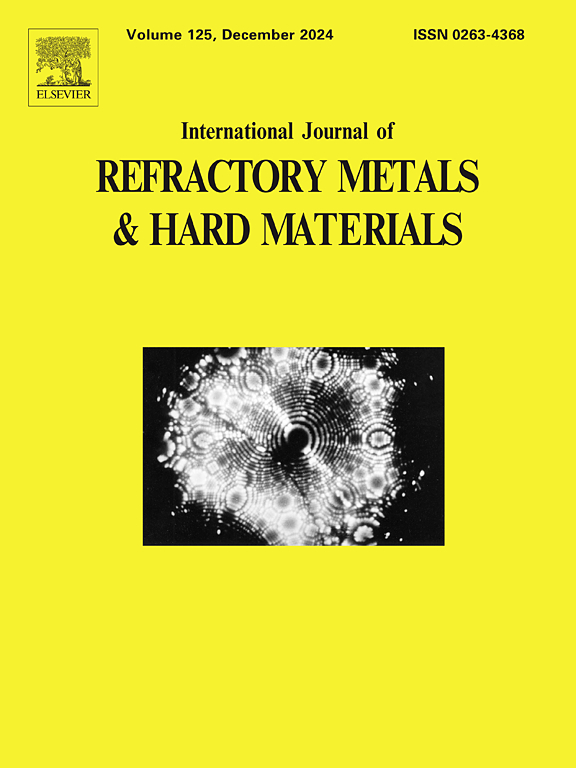Microstructure characterization and formability assessment of electron beam welded Nb-10Hf-1Ti (wt.%) refractory alloy sheets
IF 4.2
2区 材料科学
Q2 MATERIALS SCIENCE, MULTIDISCIPLINARY
International Journal of Refractory Metals & Hard Materials
Pub Date : 2024-10-05
DOI:10.1016/j.ijrmhm.2024.106912
引用次数: 0
Abstract
Formability study on welded blanks of Nb-based refractory alloy C-103 (Nb-10Hf-1Ti (wt.%)) has tremendous potential for utilizing smaller sheets for realization of large-size divergent portions of upper-stage liquid engine nozzle of satellite launch vehicles and thrusters of attitude orbital control systems. In this work, vacuum-annealed monolithic C-103 sheets were electron beam welded successfully to obtain defect-free welds and detailed microstructural and mechanical characterizations were investigated. Columnar epitaxial grains were found in fusion zone (FZ) instead of equiaxed grains in base metal (BM). Detailed SEM and HRTEM analyses revealed spherical shape of nano-sized HfO2 precipitates with monoclinic crystal structure in the C-103 sheet. Further, microhardness across the weld cross-section indicated that the FZ had a uniform and maximum hardness of ∼195 HV0.5 due to formation of finer nano-sized HfO2 precipitates with higher number density, followed by a lowering of hardness in a narrow heat-affected zone. A marginal reduction in tensile strength of ∼6% with a considerable decrease in ductility of ∼29% was noticed for the welded sample. However, fracture occurred in the BM region, indicating good weld integrity. Furthermore, formability of the welded blanks was evaluated in terms of limiting dome height (LDH), forming limit diagram, and deep drawn cup depth. The effect of the presence of WZ on the formability of the C-103 sheet was estimated under uniaxial, plane strain, and biaxial tensile strain paths for the first time, and the results were compared with the monolithic sample. It was noted that the failure limit of the welded specimens decreased compared to that of the monolithic sample, resulting in a lower LDH of approximately 69% and 62% when deformed along plane strain and biaxial tensile strain paths, respectively. However, a marginal variation in LDH was observed for the uniaxial strain path. Also, the welded blank had more resistance to material flow into the die cavity due to the harder weld region, resulting in a reduction of deep drawn cup depth by 52% than that of the monolithic blank. The overall results concluded that the presence of the WZ significantly affected the formability of the C-103 sheet, especially in plane strain and biaxial strain paths. However, the fracture was never found to be propagating along the weld line, indicating the ability of the weld to sustain large plastic strains. This study provides insightful information on the formability of electron beam welded C-103 sheets for the successful fabrication of space components.
电子束焊接 Nb-10Hf-1Ti (wt.%) 难熔合金板的显微结构表征和成型性评估
对 Nb 基耐火合金 C-103 (Nb-10Hf-1Ti(重量百分比))焊接坯料的成型性研究具有巨大潜力,可利用较小的板材实现卫星运载火箭上层液体发动机喷管和姿态轨道控制系统推进器的大尺寸发散部分。在这项工作中,对真空退火的整体 C-103 板材进行了电子束焊接,成功获得了无缺陷焊缝,并对其微观结构和机械特性进行了详细研究。在熔合区(FZ)发现了柱状外延晶粒,而不是母材(BM)中的等轴晶粒。详细的 SEM 和 HRTEM 分析表明,C-103 板材中具有单斜晶体结构的纳米级 HfO2 沉淀呈球形。此外,焊接横截面的显微硬度表明,由于形成了数量密度较高的更细的纳米级 HfO2 沉淀,FZ 的硬度均匀且最高可达 195 HV0.5,随后在狭窄的热影响区内硬度降低。焊接样品的抗拉强度略微降低了 6%,延展性大幅降低了 29%。不过,断裂发生在 BM 区域,表明焊接完整性良好。此外,还从极限圆顶高度(LDH)、成形极限图和深拉杯深等方面对焊接坯料的成形性进行了评估。在单轴、平面应变和双轴拉伸应变路径下,首次估算了 WZ 的存在对 C-103 板材成形性的影响,并将结果与整体试样进行了比较。结果表明,与整体试样相比,焊接试样的失效极限有所降低,在沿平面应变和双轴拉伸应变路径变形时,LDH 分别降低了约 69% 和 62%。不过,在单轴应变路径下,LDH 的变化不大。此外,焊接坯料由于焊接区域较硬,材料流入模腔的阻力更大,导致深冲杯深度比整体坯料减少了 52%。总体结果表明,WZ 的存在严重影响了 C-103 板材的成形性,尤其是在平面应变和双轴应变路径中。但是,从未发现断裂沿焊接线扩展,这表明焊缝能够承受较大的塑性应变。这项研究为电子束焊接 C-103 板材的成型性提供了深刻的信息,有助于成功制造太空部件。
本文章由计算机程序翻译,如有差异,请以英文原文为准。
求助全文
约1分钟内获得全文
求助全文
来源期刊
CiteScore
7.00
自引率
13.90%
发文量
236
审稿时长
35 days
期刊介绍:
The International Journal of Refractory Metals and Hard Materials (IJRMHM) publishes original research articles concerned with all aspects of refractory metals and hard materials. Refractory metals are defined as metals with melting points higher than 1800 °C. These are tungsten, molybdenum, chromium, tantalum, niobium, hafnium, and rhenium, as well as many compounds and alloys based thereupon. Hard materials that are included in the scope of this journal are defined as materials with hardness values higher than 1000 kg/mm2, primarily intended for applications as manufacturing tools or wear resistant components in mechanical systems. Thus they encompass carbides, nitrides and borides of metals, and related compounds. A special focus of this journal is put on the family of hardmetals, which is also known as cemented tungsten carbide, and cermets which are based on titanium carbide and carbonitrides with or without a metal binder. Ceramics and superhard materials including diamond and cubic boron nitride may also be accepted provided the subject material is presented as hard materials as defined above.

 求助内容:
求助内容: 应助结果提醒方式:
应助结果提醒方式:


